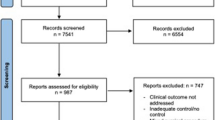Abstract
Background
Previous analyses of the safety of the conservative versus the operative approach to the treatment of liver and spleen blunt injuries in children often failed to account for differences in quality of care and expertise among dedicated pediatric trauma center, non-pediatric centers, centers without trauma units, and non-trauma centers. To eliminate this potential bias, the present study examined changes in the rate of surgery and their impact on outcome within the same medical centers over time.
Methods
The Israel Trauma Registry was searched for patients <18 years who were treated for non-penetrating liver or spleen injuries from 1998 to 2004.
Patients were grouped by period, 1998–2000 and 2001–2004, and compared for type of injury, severity of injury, type of treatment, and inpatient mortality.
Results
The earlier period (1998–2000) was characterized by a significantly higher rate of operations compared with the later period (2001–2004) (P = 0.001) and higher in-hospital mortality (P = 0.04). Injury severity scores, type of organs injured, and accompanying injuries were similarly distributed in the two groups.
Conclusions
Despite the similarity in the severity and characteristics of the intraabdominal injuries in 1998–2000 and in 2001–2004, the proportion of children treated conservatively increased over time, concomitant with a significant drop in inpatient mortality. We attribute this shift over a relatively short interval to increased experience and greater acceptance of conservative management in this setting.
Similar content being viewed by others
References
Upadhyaya P (2003) Conservative management of splenic trauma: history and current trends. Pediatr Surg Int 19:617–627
Adzick NS, Nance ML (2000) Medical progress: pediatric surgery. second of two parts. N Engl J Med 342:1726–1732
Stylianos S, Ford HR (2008) Outcomes in pediatric trauma care. Semin Pediatr Surg 17:110–115
Stylianos S, the APSA Trauma Committee (2000) Evidence-based guidelines for resource utilization in children with isolated spleen or liver injury. J Pediatr Surg 35:164–169
Leinwand MJ, Atkinson CC, Mooney DP (2004) Application of the APSA evidence-based guidelines for isolated liver or spleen injuries: a single institution experience. J Pediatr Surg 39:487–490
Stylianos S, the APSA Trauma Study Group (2002) Prospective validation of evidence-based guidelines for resource utilization in children with isolated spleen or liver injury. J Pediatr Surg 37:453–456
Meredith JW, Young JS, Bowling J et al (1994) Nonoperative management of blunt hepatic trauma: the exception or the rule? J Trauma 36:529–535
Bowman SM, Zimmerman FJ, Christakis DA et al (2005) Hospital characteristics associated with the management of pediatric splenic injuries. JAMA 294:2611–2617
Mooney DP, Forbes PW (2004) Variation in the management of pediatric splenic injuries in New England. J Trauma 56:328–333
Knudson MM, McGrath J (2007) Improving outcomes in pediatric trauma care: essential characteristics of the trauma center. J Trauma 63:S140–S142
Baker SP, O-Neill B, Haddon W et al (1994) The injury severity score: a method for describing patients with multiple injuries and evaluating emergency care. J Trauma 14:187–196
Paddock H, Tepas JJIII, Ramenofsky ML et al (2004) Management of blunt pediatric hepatic and splenic injury: similar process, different outcome. Am Surg 70:1068–1072
Stylianos S (2005) Outcomes from pediatric solid organ injury: role of standardized care guidelines. Curr Opin Pediatr 17:402–406
Malhotra AK, Fabian TC, Croce MA et al (2000) Blunt hepatic injury: a paradigm shift from operative to non operative management in the 1990s. Ann Surg 231:804–813
Author information
Authors and Affiliations
Corresponding author
Rights and permissions
About this article
Cite this article
Feigin, E., Aharonson-Daniel, L., Savitsky, B. et al. Conservative approach to the treatment of injured liver and spleen in children: association with reduced mortality. Pediatr Surg Int 25, 583–586 (2009). https://doi.org/10.1007/s00383-009-2398-7
Accepted:
Published:
Issue Date:
DOI: https://doi.org/10.1007/s00383-009-2398-7




